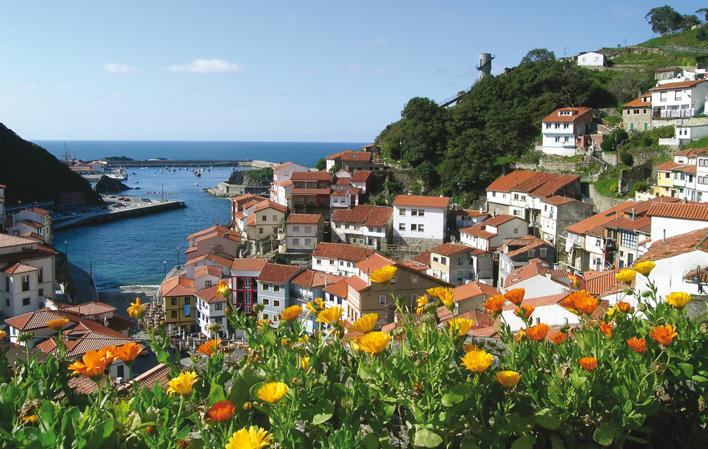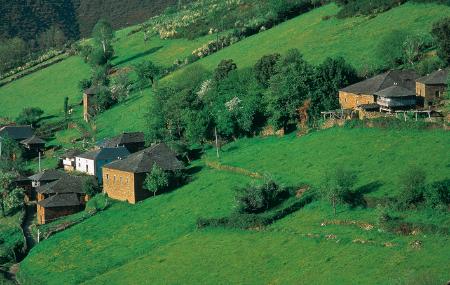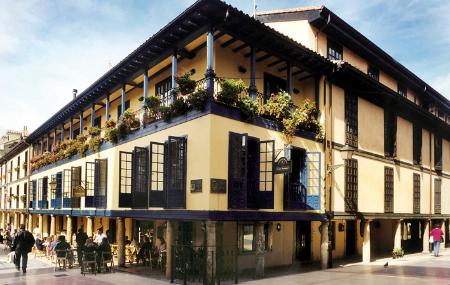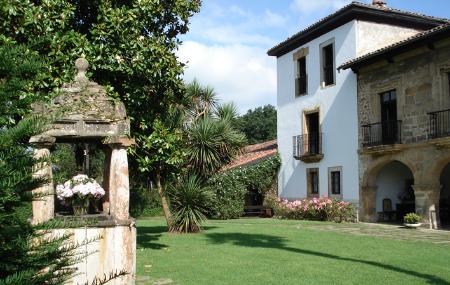
The roots of Asturias
- Address Itinerary municipalities: Castropol, Coaña, Cudillero, Avilés, Gijón, Oviedo, Lena, Langreo, Siero, Sariego, Villaviciosa, Colunga, Cangas de Onís and Llanes.
- Duration Duration: 7 days
- Distance Distance: 500,7 kms
- Difficulty Difficulty: Short
- Start point Start point: Castropol
- Route type Route type: car
- Layout of the route Layout of the route: Download kml
Travel back in time through Asturias with its architectural heritage that becomes a trace of the past and an example of what the region is today.
It is possible to take a journey through space and time at the same time when travelling through Asturias. Because, from East to West, from the coast to the interior, the architectural heritage becomes a trace of the past and an example of what the region is today. The proposed itinerary has a logical territorial order, but the pieces are interchangeable according to the traveller's taste.
Route
Castropol - Villacondide - Ḷḷuarca
Day 1: The architecture route begins on the banks of the Eo, in Castropol. In this strategic location stands the Palacete de Peñalba. Built in 1912 as a summer house by the widow of an indiano, it is an example of art nouveau in Asturias. Also in Castropol, which preserves an interesting historic quarter, stands the Palace of the Pardo Donlebún family and its gardens, whose oldest elements date from the 16th century. The next stop: the castreña culture. Half an hour to the east and only seven kilometres from Navia, in Villacondide, is the Coaña hill fort, where eighty huts are preserved, protected by a thick wall and a moat dug into the rock, from a settlement that dates back to the 4th century BC.c. Before reaching Villacondide we have the chance to see another good example of this type of settlement at the Mohías hillfort, which we will reach via a turn-off on the N-634 in the vicinity of Xarrio. Luarca is the end of the stage. In addition to its amphitheatre open to the sea, the district of Villar is dotted with some of the best examples of Indian construction, such as the villas Argentina, Excelsior or Barrera and the Casa Guatemala.
Ḷḷuarca - Avilés
Day 2: The journey continues along the coast to Soto de Luiña. In this town of Cudillero, with easy access from the Autovía del Cantábrico, is the church of Santa María and the rectory, which was a former pilgrims' hospital. This 18th-century Baroque-style complex has been declared an Asset of Cultural Interest. A quarter of an hour's journey away, in El Pito, on the outskirts of the town of Cudillero, the traveller can enjoy the Quinta Selgas, which requires an appointment to open its doors. Its exterior appearance is in keeping with the traditional Italian villas of the 16th century, although it was not built until the 19th century. Inside, it displays an exclusive art collection bequeathed by the Selgas-Fagalde family to the Asturians. The Niemeyer Centre in Avilés moves from the charm of classicism to modernity. The complex, made up of three pieces arranged in a white public square, is a design that the Brazilian architect donated to the Principality of Asturias. Also worth a visit in this city are the modernist-style Mercado de los Hermanos Orbón market and its Plaza de Las Aceñas, and the old quarter, with the characteristic arcades of Calle Galiana.
Avilés - Gijón/Xixón
Day 3: Gijón and its Roman remains are the focus of this day. On the outskirts of Gijón/Xixón, on the western flank, is the Campa Torres Natural Archaeological Park. This space, located on a watchtower overlooking the sea, consists of three buildings: the reception, the museum and the lighthouse. The visit revolves around the remains of an ancient maritime fort, whose origins date back to the 6th century BC. In the centre, next to the church of San Pedro, are the Roman baths of Campo Valdés, from the 1st century AD. Apart from the archaeological heritage, the city has buildings of great beauty, such as the Palace of Revillagigedo and the house where Jovellanos was born, both next to the Town Hall square, or the bullring of El Bibio. Veranes, twenty minutes from the centre, preserves the remains of a Roman site. A visit to the site, which is accessible, reveals the archaeological remains of a villa from the 4th century AD that was built on top of an earlier settlement. To the east of the city centre, the traveller will find the imposing Laboral City of Culture, with a surface area of 27,000 square metres, today partially refurbished for cultural and educational uses.
Gijón/Xixón - Oviedo/Uviéu
Day 4: Towering over the skyline of Oviedo/Uviéu are the bell tower of its Cathedral and the Calatrava-designed Congress Centre. They are the two highest points of the city, the present and the past, which demand the traveller's attention. The construction of the Cathedral of San Salvador began in the 13th century on the site of an ancient pre-Romanesque church. The work went on for three more centuries, so it includes remains of Romanesque, Renaissance and Baroque styles. The cathedral is located in the heart of the historic centre, which deserves a leisurely stroll through its pedestrian streets. The Calatrava conference centre, one of the most unique buildings in the city, is located in the Buenavista district. Inaugurated in 2011, it houses a shopping centre, an auditorium, a hotel and offices. But the most representative element of Oviedo's architecture is the Asturian Pre-Romanesque, a style that developed between the 8th and 10th centuries, which can be seen in the fountain of La Foncalada and the churches of San Julián de los Prados, San Miguel de Lillo and Santa María del Naranco. The first two are within the town centre. To access the last two it is necessary to climb Monte Naranco, where there is also a reception and interpretation centre (check opening times).
Oviedo/Uviéu - Lena - Langreo
Day 5: To the south, the mining basins open up, where much more than coal can be found. Santa Cristina de Lena, 36 kilometres south of Oviedo/Uviéu on the A-66, is another of the best examples of Pre-Romanesque architecture. The church of Santa Cristina was built in the mid-9th century and stands on a hill with privileged views. Returning north on the A-66, you can take the turn-off to Uxo and Turón to reach the mining village of Bustiello, a small village built between 1890 and 1925 by Hullera Española, which has been restored. Here you can visit the church, the old casino, the sanatorium and the houses, built on the model of the Mulhouse houses, which won prizes at the Paris Exhibition in 1867. From Mieres, the Autovía Minera (Mining Motorway) takes tourists to Langreo, where they can visit another example of architecture linked to coal mining: the Samuño Valley Mining Ecomuseum, in the old San Luis Pit. These facilities are located in the village of El Cadavíu (Ciañu) and include the experience of an old mining train on a two-kilometre journey. But it also has other much more modern examples, such as the Juan Carlos Beiro Sports Centre, whose original design has received several awards.
Langreo - La Pola Siero - Colunga - Arriondas/Les Arriondes
Day 6: The architectural route continues eastwards with a first stop in La Pola Siero to enjoy its market square, the work of the engineer Ildefonso Sánchez del Río. The uniqueness of the market, dating from 1930, lies in the shape of its vaulted roof and an interior that rises up without a single column. Towards the east, the options multiply. If you leave La Pola Siero on the N-634, you can find the Romanesque churches of San Esteban, in Aramil, and Santiago and Santa María de Narzana, both in Sariego. On the other hand, if you choose to take the Autovía del Cantábrico towards Santander, you will quickly reach Villaviciosa and from there, along the AS-267 road, you will arrive at Valdediós. The destination of this detour is to see the monastery of Santa María la Real and El Conventín, another legacy of the Pre-Romanesque period. Back on the dual carriageway, the journey continues to Colunga where, 4 kilometres from the capital, you will find the pre-Romanesque church of Santiago de Gobiendes. From Colunga you can return inland via the Alto del Fito to reach Arriondas/Les Arriondes. At the top, there is a surprising viewpoint with an original design, inaugurated in 1927.
Arriondas/Les Arriondes - Cangues d'Onís/Cangas de Onís - Llanes - Colombres
Day 7: After strolling through Arriondas/Les Arriondes, along the banks of the river Sella, through its unique squares, the last day of the route begins. The first stop is Cangues d'Onís/Cangas de Onís, at the Monastery of San Pedro de Villanueva, now converted into a Parador Nacional, built in the 8th century on pre-Romanesque ruins. You cannot leave the area without seeing the centre of Cangas and its Roman bridge, a structure which, curiously enough, is so named because of its style but which actually dates from a later period. The route continues on to Llanes (an hour's journey), where you can return to Arriondas/Les Arriondes to take the N-634, which leads to the Cantabrian motorway, or continue along the AS-114 and AS-115, a much more picturesque route. In the town of Llanisca, you can stroll through the interior of its medieval historic-artistic complex and also compare this setting with more modern buildings of Indian architecture. The Asturian emigrants to America occupied the beginning of the journey and will also do so in the final stretch. The Indianos Archive opened its doors in Colombres, Ribadedeva, in the Quinta Guadalupe, a space of great beauty.
Map
Itinerary
Orillas del Eo - Castropol - Coaña - Luarca/Ḷḷuarca - Cudillero - Avilés - Gijón - Oviedo/Uviéu - Lena - Langreo - La Pola Siero - Sariego - Villaviciosa - Colunga - Cangues d'Onís/Cangas de Onís - Llanes




